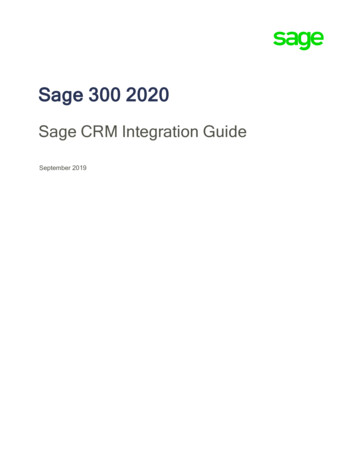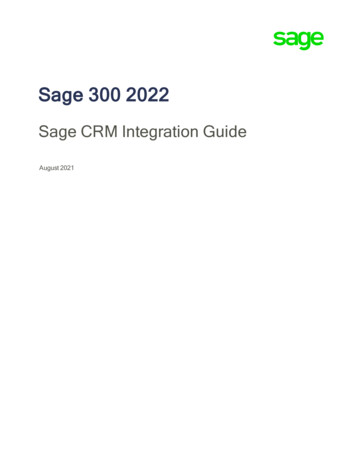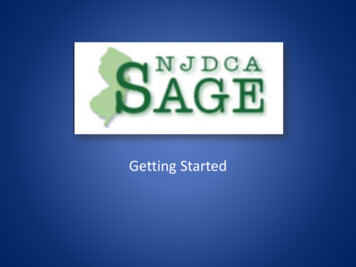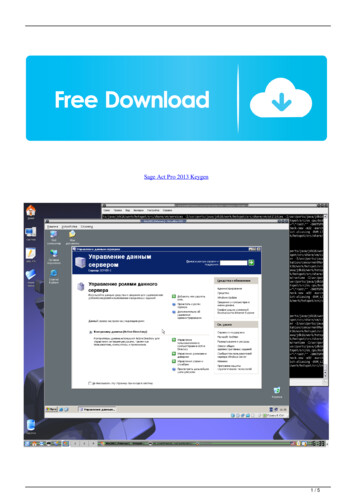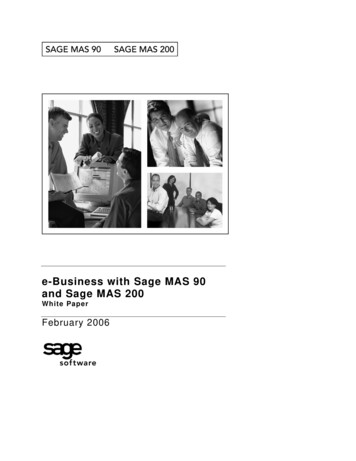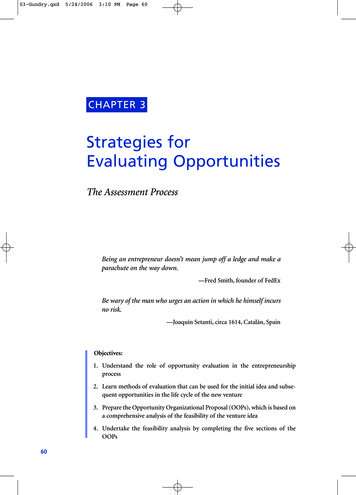
Transcription
03-Gundry.qxd5/24/20063:10 PMPage 60CHAPTER 3Strategies forEvaluating OpportunitiesThe Assessment ProcessBeing an entrepreneur doesn’t mean jump off a ledge and make aparachute on the way down.—Fred Smith, founder of FedExBe wary of the man who urges an action in which he himself incursno risk.—Joaquín Setanti, circa 1614, Catalán, SpainObjectives:1. Understand the role of opportunity evaluation in the entrepreneurshipprocess2. Learn methods of evaluation that can be used for the initial idea and subsequent opportunities in the life cycle of the new venture3. Prepare the Opportunity Organizational Proposal (OOPs), which is based ona comprehensive analysis of the feasibility of the venture idea4. Undertake the feasibility analysis by completing the five sections of theOOPs60
03-Gundry.qxd5/24/20063:10 PMPage 61Strategies for Evaluating Opportunities——61Strategy in ActionScott Cook, Founder of IntuitScott Cook is the founder of Intuit, the company that developed Quicken and Quickbooks, thepersonal and business financial tools. He has been Intuit’s CEO for more than 22 years, building the company into a 1.7 billion enterprise. While most people are familiar with Intuit’sprogress and are likely to have used one of its products to help manage their personal or business finances, Cook’s entrepreneurial journey is not widely known.In 1983, when he launched Intuit, Cook already had significant corporate experience. Heheld an MBA from Harvard and had worked at Procter & Gamble as a brand manager and atBain as a consultant. Cook’s founding principle was, “Listen to your customers.” His strategywas in place before the publication of In Search of Excellence, by Tom Peters and Bob Waterman,the book that made paying attention to your customers a core business value of excellent companies. Consider this Cook program, which emerged during the early days of Intuit, calledFollow Me Home.Intuit employees were assigned to stay in the local computer store until someone boughtQuicken off the shelf (this was back when people did that sort of thing). The employees wouldthen ask the buyers to take them home so they could see how difficult the product was to install.By observing customers at home, Intuit employees could gain valuable insights from everyaction, from how easily the shrink-wrap came off to which lines of the directions caused frustration. Cook insists, “If there were problems, the fault was Intuit’s, not the customer’s. Everypause, every source of frustration, [was] evidence of something Intuit needed to fix.” Cookbelieves in radical simplification. He always knew that Intuit had to do more than just makeQuicken better and easier than every other software program; it needed to make Quickenbetter and easier than the pen and paper check-writing process that Quicken aimed to replace.Cook knew that if he and his company were alert and creative and open-minded enough, thenaccomplishing this was possible: Their customers would tell them how.Cook’s assumption proved to be true. During Intuit’s second decade, “customers inventedour mid-market business before we even saw the possibility.” Entrepreneurs had begun usingQuicken to run the finances of their companies, modifying the program to suit their needs. Thelaunch of Quickbooks came in 1992, and it allowed small businesses to manage their money inways that had not been possible. By the end of its first full month on the market, Quickbooksbecame the best-selling accounting software. Cook claims this happened because of the fundamental innovation in Quickbooks. “It didn’t come out of any big fancy R&D lab. It came out ofus being closer to understanding the customer and the prospect than anyone else.”One of the key pieces of advice Cook shared for budding entrepreneurs is especially appropriate during the phase of the life cycle when the opportunity is being assessed and the entrepreneur wants to find out whether or not the concept will work. What does Cook advise?“Behave humbly. Be humble about your importance, about how many answers you know,and about how much you don’t know (which is always more than you think), humble about theneed to engage with and learn from people around you, humble about customers, humble aboutlearning. Please understand that I’m saying behave humbly; I don’t think you can actually willyourself to be humble, but you can behave humbly. Which means saying, often, ‘I was wrong.’(Continued)
03-Gundry.qxd5/24/20063:10 PMPage 6262——ENTREPRENEURSHIP STRATEGY(Continued)Which you’ll discover is the moment when the real insights and breakthroughs occur. Andwhen it’s hard to behave humbly because you’re afraid people won’t value you, just remember:People already know, they can see through you. They know what you’re good at and what you’renot, so don’t pretend. Instead, try being true. Be human and vulnerable, the way you really are.And you’ll find that by admitting you’re not good at stuff, you build a bridge to people. You givethem room to contribute.”Cook says, “Realize that to a scary degree a company grows to reflect its founder. Unlike withyour kids, there are no unalterable genetics to blame, it’s all nurture. You get to start the code.So be customer-driven. My biggest surprise was discovering how customers will invent yourbusiness for you. And commit to the right values—be straight, tell the truth. Especially the badnews. You’ll discover that people always get over it, and even admire the effort you make tryingto fix things. Short-term losses become long-term gains.”SOURCE: M. Hopkins, “25 Entrepreneurs We Love,” INC, April 1, 2004. Retrieved February 13, 2006, ml; C. Tkaczyk, “The Best Ideas Come From the FrontLine,” Fortune, Nov. 15, 2004, p. 193.Opportunity Evaluation:Will the Idea for the New Venture Work?Once entrepreneurs have developed the idea(s) for the new ventures, they mustbegin the process of assessing whether or not the idea is in fact a viable businessopportunity. Many new ventures have been launched around bad business ideas.An idea can seem sound in theory but in reality have poor marketplace potential.While failures can also be attributed to poor execution of the idea, it is importantto assess feasibility as early as possible to avoid the much costlier effects of failedimplementation. So how do entrepreneurs determine if an idea is an appropriateinvestment for their resources?The U.S. Patent Office has granted some unusual patents in its history. Consider,for example, whether necessity really drove these inventions (Jones, 1991). A propeller-driven rocking chairAn automatic spaghetti-spinning forkA power-operated pool cue stickA baby-patting machineAn electronic snore depressorA parakeet diaperAn alarm clock that squirts the sleeper’s faceAs you can see from these amusing examples, assessing an idea’s potential tobecome a good business opportunity is absolutely necessary to avoid the allocation
03-Gundry.qxd5/24/20063:10 PMPage 63Strategies for Evaluating ityRecognitionIndustry & MarketNeeds,Expectations,and ies in Knowledge,Awareness, and InformationFigure 3.1Opportunity Recognition to Opportunity Evaluation: The AssessmentProcessof scarce resources, including the entrepreneur’s time and effort. As we have seen inChapter 2’s discussion of opportunity identification, the process begins by determining the unique needs of the industry and marketplace, including what customersexpect and demand that the new venture can provide. Many ideas and opportunitiesexist; however, resources are scarce, and this means that you must be very careful inyour evaluation of business opportunities to be sure they can be supported by theknowledge and information you possess or can obtain fairly easily. Figure 3.1 illustrates the movement from opportunity identification to opportunity evaluation.The evaluation process begins with some fundamental questions to help entrepreneurs assess the potential for the new venture to succeed. Evaluation of businessopportunities should be conducted not just by the entrepreneur but also by asmany stakeholders in the new venture as possible: potential customers or clients,employees, advisers, investors, and suppliers.Four Primary Areas for AssessmentThere are many questions to ask during opportunity evaluation, and they can beclassified according to four primary areas for exploration:1. The people behind the idea: the background, talents, and experience of theentrepreneur and the management team, employees, and advisers. Even a great ideawith high market potential requires an entrepreneur or team behind it that can effectively (and passionately) support and grow the idea. It is then much more likely to besuccessful. An entrepreneur’s skills and talents might have led to the discovery of theidea, but does the entrepreneur have the competence to turn the idea into a business?
03-Gundry.qxd5/24/20063:10 PMPage 6464——ENTREPRENEURSHIP STRATEGY2. The resources available to the entrepreneur and the management team,including the equity and debt sources of capital that are available and accessible,additional assistance from people with expertise needed by the firm, and the technology required to support the idea. What relationships can the entrepreneur orteam rely on to acquire the necessary resources?3. The knowledge and information possessed by the entrepreneur, including knowledge of the new venture concept, the industry, and market research.Moreover, what is not known that needs to be known for the new venture to be successful? Information about competitors? About customers’ preferences? How willthis information be obtained?4. The idea’s ability to generate revenue. How great is the potential to sell something that will generate actual revenues? One of the mistakes would-be entrepreneurs make is to assume that everyone will love the idea and that people will bestanding in line to buy it, once the business opens. To what degree can the entrepreneur manage and contain the costs while maximizing returns?These questions form the basis for the opportunity evaluation, and their answerswill help the entrepreneur move forward to create strategies that ultimately supportthe viable business model.Review Questions1. How do the four questions for assessing a business opportunity help entrepreneurs evaluate whether their business idea is viable?2. Do you think entrepreneurs should proceed with an idea that has inherentweaknesses in any of these areas?The Innovator’s Toolkit:Business Evaluation Scoring Technique (BEST)The Business Evaluation Scoring Technique (BEST) was developed to help entrepreneurs evaluate a group ofideas before deciding which ones to pursue. The tool considers the various “windows of opportunity” relatedto new ventures. Answer the following questions by scoring them on a 1–5 scale: 1 low and 5 high.1. Is the business really differentiated from other similar businesses?2. Does the business have growth potential?3. Will the business require capital? (Note: A low dollar requirement receives a higher score, while a highdollar requirement should receive a low score)4. Can financing be secured?5. Does the business suit the individual’s entrepreneurial profile (e.g., mind-set, experience)?
03-Gundry.qxd5/24/20063:10 PMPage 65Strategies for Evaluating Opportunities——65Total ScoreDescriptionAction20–25Excellent prospectsMust try15–19Very good prospectsShould try11–14Reasonable prospectsTry if nothing else is available10 and underPoor prospectsAvoid this loserSOURCE: Edward Williams, http://www.entrepreneurialprocess.com/new site/best technique.htm. Reprinted with permission.Assessing the Feasibility of the New Venture IdeaEvaluating a new venture idea involves testing its feasibility, the extent to which theidea is a viable and realistic business opportunity. One of the first steps required inassessing the feasibility of an idea is to become aware of forces and factors in the internal and external environment that directly influence the new venture opportunity.Factors internal to the venture include: The knowledge, skills, and abilities of the entrepreneur, the management teammembers, employees, and advisers The resources available to the entrepreneur, including people, financial resources,and technologies that can be acquired for the launch and growth of the opportunityFactors external to the new venture include: The industry: competitors, structure of the industry, barriers to entry, andtrends that affect businesses in the sector in which the new venture intends to locate The market: knowledge of the preferences, values, and buying behavior of thetarget market, including demographic and psychographic information necessary toappropriately position, promote, and price the products and services Social norms, values, and trends surrounding the new venture idea. Is it afad? Is there an increasing need for or awareness of the product or service? Are thereethical concerns about the product, service, or its effects? Realize that a productor service (and any of its components) may be legal but unethical. The socialenvironment of a new venture often involves the perceptions—not necessarily thereality—of the opportunity in the minds of customers and citizens. Legal and regulatory forces that could affect the business operations, includinglaws, policies, procedures, and regulations pertinent to the industry or municipality in which the new venture is locatedConducting an environmental feasibility analysis will help the entrepreneurprepare a strategic plan—the topic of Chapter 4.
03-Gundry.qxd5/24/20063:10 PMPage 6666——ENTREPRENEURSHIP STRATEGYIn the next section, we examine the major questions to ask that will help youdetermine the feasibility of your business opportunity. A model that can guide theentrepreneur through the opportunity evaluation process is presented.Fourteen Questions to Ask Every TimeTo evaluate opportunities, Allis (2003) has developed a set of questions for entrepreneurs.1 The answers are helpful as entrepreneurs prepare to conduct a comprehensivefeasibility analysis and to develop subsequent strategies for the emerging venture.1. What is the need you fill or problem you solve? (value proposition)2. To whom are you selling? (target market)3. How could you make money? (revenue model)4. How will you differentiate your company from what is already out there?(unique selling proposition)5. What are the barriers to entry?6. How many competitors do you have and of what quality are they? (competitive analysis)7. How big is your market in dollars? (market size)8. How fast is the market growing or shrinking? (market growth)9. What percent of the market do you believe you could gain? (market share)10. What type of company would this be? (lifestyle or high growth potential,sole proprietorship or corporation)11. How much would it cost to get started? (start-up costs)12. Do you plan to use debt capital or raise investment? If so, how much andwhat type? (investment needs)13. Do you plan to sell your company or go public (list the company on thestock markets) one day? (exit strategy)14. If you take on investment, how much money do you think your investorswill get back in return? (return on investment)Strategic Reflection PointALUO to Evaluate the New Venture IdeaALUO (Advantages, Limitations, Uniqueness, and Opportunity) is a useful tool that enables theentrepreneur to examine the advantages and limitations of an idea. Most entrepreneurs do this,but ALUO is helpful because it also asks you to consider what is unique about the idea and whatopportunity emerges from the advantages, limitations, and uniqueness of the idea (Gundry &LaMantia, 2001).
03-Gundry.qxd5/24/20063:10 PMPage 67Strategies for Evaluating Opportunities——67A: What are the advantages of the idea? How does it build on or extend what is already availablein the market?L: What are the limitations of the product or service? This may be hard for the entrepreneur toassess realistically (watch out for idea infatuation!). You may want to ask others for their opinionson this. What elements of your idea might not work as well as predicted? What flaws might exist?U: What is unique about the idea? What can’t be substituted by something already availablein the marketplace? Is your idea easily imitated by others? How can the entrepreneur make itdifficult for others to copy? If the product or service is not unique, are there ancillary productsor services that could be packaged to maintain uniqueness?O: What opportunities emerge from the unique features and advantages (or even the limitations, as you consider ways these could be minimized)?The Feasibility Analysis:Beginning the Evaluation ProcessThe KIC: Knowledge of Industry ChecklistWhile it may be tempting to take the leap into writing a business plan as soon asyou develop and refine your business idea or opportunity, this can prove to be aserious mistake. Many would-be entrepreneurs underestimate their competitors(both in number and in capability) and therefore develop entrepreneurship strategies that have no likelihood of success. Don’t fall into that trap—idea infatuation isone of the strongest predictors of business failure because infatuated entrepreneursignore or discount objective industry and market data that even slightly questionstheir idea. To increase the odds of success and help you identify potential flawsand areas for improvement a priori, start with the KIC: Knowledge of IndustryChecklist. A complete industrial analysis usually includes a review of an industry’srecent performance, its current status, and the outlook for the future. Many analyses include a combination of text and statistical data. Some of the points entrepreneurs consider in this analysis are given below.Current Industry Analysis Describe the industry as specifically as possible. Some business ideas fall intomore than one industrial classification. What are the current trends in the industry? What is the current size of the industry? Is it dominated by large players? Arethere a significant number of small to medium-size enterprises in the industry? Where is the industry located? Is it local, regional, national, or global? What is the average sales and profitability for this industry?
03-Gundry.qxd5/24/20063:10 PMPage 6868——ENTREPRENEURSHIP STRATEGYThe Innovator’s Toolkit:Give Me FiveWhen you have gathered preliminary information about your industry, try this challenge to push thinkingforward with respect to this industry. Your responses to this exercise will help you formulate your competitivestrategy for successful industry entry and growth (Gundry & LaMantia, 2001). Give Me Five things you have observed as a consumer or employee of this industry.Give Me Five things businesses in this industry should be thinking about right now.Give Me Five things customers of this industry would tell you if you asked them.Give Me Five actions or behaviors businesses in this industry should take within the next six months totwo years to remain competitive. Give Me Five ideas that businesses in this industry haven’t even thought about yet.Competitor Analysis Obtain basic information on the competitors you have identified. Who arethe direct competitors of the new venture? Where are the competitors located? Be careful not to assume that a competitor located across the country—or the world—is not a direct competitor.Many firms conduct business on-line, and a remote competitor may prove tobe a formidable one if it has a strong on-line presence. What are the advantages and disadvantages of the competitors? What features of their products or services are similar to yours? How are your products or services distinctive from those of your competitors? This is a key part of the competitive analysis.The following worksheet will help you gather data about your competitors. Useadditional worksheets to identify more competitors. You will use the informationin this worksheet, Table 3.1, to help you develop your competitive strategy inChapter 4.Sources of Information for theIndustry and Competitor AnalysisThere are many sources of industry analysis: investment firms, business andtrade periodicals, trade associations, and government agencies. To conduct a thorough industry analysis, include a variety of sources. Appendix 3.1 contains somerecommended sources for your research, including Internet and print sources. Asyou conduct your research, don’t neglect to record your own personal observations:Visit competitors in a nondisruptive manner. What do you notice? What could beimproved? How is the product or service used? Create the experience of being acustomer of this business and industry.
03-Gundry.qxd5/24/20063:10 PMPage 69Strategies for Evaluating Opportunities——69Table 3.1Worksheet for Competitor ssNameBusinessNameBusinessNameKey product orserviceLocation(s)Local, regional,national orglobal?Primary featuresof product orserviceAdvantages ofproduct orserviceDisadvantages ofproduct orserviceTarget marketMarket sharePricing(Continued)
03-Gundry.qxd5/24/20063:10 PMPage 7070——ENTREPRENEURSHIP STRATEGYTable 3.1 tiesKnowledge, skills,and abilities ofkey staffResourcesImageCulture of thebusiness (normsand values)FinancialconditionHow is yourventuredistinctive fromthis competitor?Failures and FoiblesKnowing What’s Not a Good OpportunityIn 2005, for the fourth year in a row, Stew Leonard’s, a family-owned fresh food store withlocations in Norwalk and Danbury, Connecticut, and Yonkers, New York, has been named toFortune magazine’s “100 Best Companies to Work For” list. The company placed 29 on the 2005list, when for the first time, companies were also listed by their size—large, mid-size, and small.
03-Gundry.qxd5/24/20063:10 PMPage 71Strategies for Evaluating Opportunities——71Stew Leonard’s, a small company with less than 2,000 employees, is ranked 15 when comparedto other small companies that also made the list. Stew Leonard’s was dubbed the “Disneyland ofDairy Stores” by the New York Times because of it had its own milk processing plant and costumed characters, scheduled entertainment, a petting zoo, and animatronics were in its stores.The company has received worldwide acclaim for excellence in customer service and quality andis featured in two of management expert Tom Peters’s books: A Passion for Excellence andThriving on Chaos. In 1992, Stew Leonard’s earned an entry into The Guinness Book of WorldRecords for having “the greatest sales per unit area of any single food store in the United States.”Tom Leonard, son of the founder, was walking around the store one day when he wasapproached by a man who asked if the store carried shaving cream. Tom replied that it did not.The man went on to explain that shaving cream was one of the hottest items in grocery stores,and Stew Leonard’s ought to get some. Tom admitted that was an interesting fact and took outhis day-timer to made a note of it. The customer interrupted and said, “Tom, today is your luckyday. I sell shaving cream.” Tom got excited and placed the order right there. “And the first week,”he notes, the shaving cream “sold very well.”However, sales slid, and within a few weeks, Tom learned that the shaving cream was notmoving, and the stores were stuck with trailer loads of the product. Tom realized that shavingcream was unlike most of the products sold at Stew Leonard’s Dairy: It was not perishable.Customers had purchased the shaving cream during the first week or two, but then they wereset for a few months and didn’t need any more.But Tom was not discouraged: “When we have a situation such as this, we know what to do.”So he had the advertising department draw up a sign that said, “Shaving Cream: 99 cents a can.Buy 1, get 2 free.” Tom recalls that he then learned the biggest marketing lesson of his life:“If the customers don’t want one, they surely don’t want THREE! It took us months to getrid of the stuff.”Tom’s story is an important one because it reminds entrepreneurs that what might appear tobe a great opportunity just might not be a good fit with your business.SOURCE: http://www.stewleonards.comFrom KIC to OOPs:The Opportunity Organizational ProposalIn the first section of this chapter, we examined the key factors that are part ofthe opportunity assessment. A comprehensive feasibility study is conducted tohelp the entrepreneur determine whether the opportunity can lead to the emergence and growth of a successful organization. The Opportunity OrganizationalProposal is composed of five major sections. You can use the detailed outlinebelow as you analyze the potential of a business opportunity and decide whetheror not to move ahead and create the new organization. The worksheets you willneed for investigating financial feasibility are found in Appendix 3.1 at the end ofthis chapter.
03-Gundry.qxd5/24/20063:10 PMPage 7272——ENTREPRENEURSHIP STRATEGYOutline for the OpportunityOrganizational Proposal: Feasibility AnalysisDescription of Your BusinessWhat business are you really in? Describe your product or service in the mostconcise way you can, and think beyond the characteristics of the product or serviceto the experience that you hope the customer receives from buying the productor service.The Product or Service Describe what you are selling and how it will benefit your customers. Explainhow your product or service is different from the competition. Answer the question, “Why will people buy from me?” (your product/service concept, benefits, andcustomer profile). It is important that you can concisely and accurately describeyour product or service in terms that are relevant to your customer and that thecustomer can understand. The ability to describe your product or service will be acritical factor in the success of your marketing and advertising. What are the thingsabout your product or service that are important to your customer? What wordsimmediately create an image of your business? What are the unique characteristics of your product or service? What arethe unique features of the product or service? How do these features meet yourcustomers’ needs or preferences? What are the benefits of this product or servicecompared to the competition? Describe your product or service very simply, anduse photos or drawings to illustrate how it works. What are the specific shortcomings of the product or service? Can it becomeobsolete soon? Is it perishable, is it difficult to use or install, or are there legalrestrictions? An honest assessment of your product or service is extremely important during this analysis. Entrepreneurs do themselves no favor by being in denialor failing to see the disadvantages before going into business. Noting them now willhelp you prepare solutions or ways to minimize these issues. What is your product’s stage of development? Is the product still in the ideastage, or is there a model or working prototype available? Have any samples beenmanufactured? If it is still in the idea or prototype stage, what is the time frame forgetting it ready for production. Research any legal restrictions and rights. List any patents, copyrights, trademarks, or licenses that apply to your product or service. If you are entering intoa franchise agreement, partnerships, distributorships, and so on, these should bediscussed in this section. Seek the assistance of patent attorneys or intellectualcopyright specialists for assistance. Also, list the government regulations with whichyou must comply, including any government approvals required, and research zoning restrictions carefully. If you will be home based and your clients will be comingto your house, will your neighborhood’s zoning restrictions be an issue?
03-Gundry.qxd5/24/20063:10 PMPage 73Strategies for Evaluating Opportunities——73 What are the insurance requirements? Research the liability of your product orservice, and consult an insurance specialist to be sure you are protected adequately.This will depend on the nature of your business. A landscape design firm is in a different liability situation than a children’s gymnastics and fitness center, for example. If you have employees, you will need insurance to protect them from harm also,along with any insurance benefits you want to provide your staff. Estimate production or service delivery costs. Will you be producing or subcontracting out the manufacturing or delivery of your product or service? List allthe costs, including labor, supplies, shipping, repairs, and so on.The Industry and Market Describe the current industry. Determine the trends present in the industry,the size of the industry, the location, and the average sales and profitability of theindustry. Use the KIC (Knowledge of Industry Checklist) presented earlier in thechapter for this section of the feasibility analysis. What is the market potential for your idea? Describe the market for yourproduct or service as specifically as possible. Is the industry in a period of growth,stability, or decline? Can you predict the demand for your product or service overthe next six months to two years? Would-be entrepreneurs should interview business owners, managers, or other insiders in the industry to learn about trends andmarket potential for the industry. What is the impact of technology on the industry and market? What is the levelof technology in use in the industry today? How available or accessible is that technology to the entrepreneur? How can you remain up-to-date with technologicalchanges in this industry? What resources will be required to access the technologyat start-up? During the growth stage several months ahead? What economic and legal/regulatory factors affect this industry? Are thereglo
ness finances, Cook's entrepreneurial journey is not widely known. In 1983, when he launched Intuit, Cook already had significant corporate experience. He held an MBA from Harvard and had worked at Procter & Gamble as a brand manager and at Bain as a consultant. Cook's founding principle was, "Listen to your customers." His strategy
